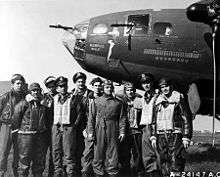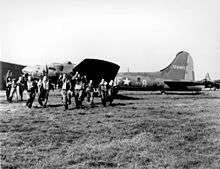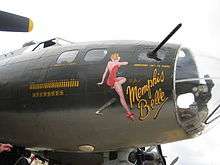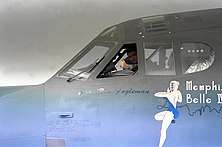Memphis Belle (aircraft)
Memphis Belle is a Boeing B-17F Flying Fortress used during the Second World War that inspired the making of two motion pictures: a 1944 documentary film, Memphis Belle: A Story of a Flying Fortress, and a 1990 Hollywood feature film, Memphis Belle. The aircraft was one of the first United States Army Air Forces B-17 heavy bombers to complete 25 combat missions. The aircraft and crew then returned to the United States to sell war bonds.[2] In 2005, restoration began on the aircraft at the National Museum of the United States Air Force at Wright-Patterson AFB in Dayton, Ohio where, from May 2018, it is on display.[3][4]
| Memphis Belle | |
|---|---|
 | |
| Boeing B-17F-10-BO Flying Fortress, AAF Ser. No. 41-24485, Memphis Belle, 324th Bomb Squadron, 91st Bomb Group, 9 June 1943 | |
| Type | Boeing B-17F Flying Fortress |
| Manufacturer | Boeing Aircraft Company |
| Construction number | 3470[1] |
| Serial | 41-24485 |
| Radio code | DF-A |
| Owners and operators | United States Army Air Forces |
| Fate | On display |
| Preserved at | National Museum of the United States Air Force |
Crew

The crew for the Memphis Belle are as follows:[5]
- Pilot: Captain Robert K. Morgan
- Co-pilot: Captain James A. Verinis
- Navigator: Captain Charles B. Leighton
- Bombardier: Captain Vincent B. Evans
- The First Engineer/Top Turret Gunner: Leviticus "Levy" Dillon
- The Second Engineer/Top Turret Gunner: Eugene Adkins
- The Third Engineer/Top Turret Gunner: Harold P. Loch
- Radio Operator: Robert Hanson
- Ball Turret Gunner: Cecil Scott
- Right Waist Gunner: E. Scott Miller
- Right Waist Gunner: Casmer A "Tony" Nastal
- Left Waist Gunner: Clarence E. "Bill" Winchell
- Tail Gunner: John P. Quinlan
- Crew Chief: Joe Giambrone
Combat history

The Memphis Belle, a Boeing-built B-17F-10-BO, manufacturer's serial number 3470, USAAC Serial No. 41-24485, was added to the USAAF inventory on 15 July 1942,[6] and delivered in September 1942 to the 91st Bombardment Group at Dow Field, Bangor, Maine.[7] It deployed to Prestwick, Scotland, on 30 September 1942, moving to a temporary base at RAF Kimbolton on 1 October, and then finally to its permanent base at RAF Bassingbourn, England, on 14 October.[7] Each side of the fuselage bore the unit and aircraft identification markings of a B-17 of the 324th Bomb Squadron (Heavy); the squadron code "DF" and individual aircraft letter "A."[6][8]
Captain Robert K. Morgan's crew flew 29 combat missions with the 324th Bomb Squadron, all but four in the Memphis Belle. The aircraft's 25 combat missions, which included eight German aircraft shot down by its crew, were:
- 7 November 1942 – Brest, France[9][N 1]
- 9 November 1942 – St. Nazaire, France [9]
- 17 November 1942 – St. Nazaire, France[9]
- 6 December 1942 – Lille, France[9]
- 20 December 1942* – Romilly-sur-Seine, France [9][10][11]
- 30 December 1942 – Lorient, France (flown by Lt. James A. Verinis)
- 3 January 1943 – St. Nazaire, France[9]
- 13 January 1943 – Lille, France[9]
- 23 January 1943 – Lorient, France[9]
- 14 February 1943 – Hamm, Germany[9]
- 16 February 1943 – St. Nazaire, France[9]
- 27 February 1943* – Brest, France[9][N 2]
- 6 March 1943 – Lorient, France[9]
- 12 March 1943 – Rouen, France[9]
- 13 March 1943 – Abbeville, France [9]
- 22 March 1943 – Wilhelmshaven, Germany [9]
- 28 March 1943 – Rouen, France[9]
- 31 March 1943 – Rotterdam, Netherlands [11][13][14]
- 16 April 1943 – Lorient, France[9]
- 17 April 1943 – Bremen, Germany [9]
- 1 May 1943 – St. Nazaire, France[9]
- 13 May 1943 – Meaulte, France (flown by Lt. C.L. Anderson)
- 14 May 1943 – Kiel, Germany (flown by Lt. John H. Miller)
- 15 May 1943 – Wilhelmshaven, Germany[9]
- 17 May 1943 – Lorient, France[9]
- 19 May 1943* – Kiel, Germany (flown by Lt. Anderson) [N 3]
* Sources disagree on which two of these three missions the Memphis Belle received mission credits for.
Morgan's crew completed the following missions in B-17s other than the Memphis Belle:
- 4 February 1943 – Emden, Germany (in B-17 DF-H 41-24515 Jersey Bounce)[16]
- 26 February 1943 – Wilhelmshaven, Germany (in B-17 41-24515)[17]
- 5 April 1943 – Antwerp, Belgium (in B-17 41-24480 Bad Penny)[17]
- 4 May 1943 – Antwerp, Belgium (in B-17 41-24527, The Great Speckled Bird)[18]
The aircraft was then flown back to the United States on 8 June 1943, by a composite crew chosen by the Eighth Air Force from those who had flown combat aboard, led by Capt. Morgan, for a 31-city war bond tour. Morgan's original co-pilot was Capt. James A. Verinis, who himself piloted the Memphis Belle for one mission. Verinis was promoted to aircraft commander of another B-17 for his final 16 missions and finished his tour on 13 May. He rejoined Morgan's crew as co-pilot for the flight back to the United States.
The B-17 Hell's Angels (41-24577) of the 303rd Bomb Group completed 25 combat missions on 13 May 1943, becoming the first B-17 to complete the feat, one week before the Memphis Belle.[19][20]
Source of the name
The aircraft was named after pilot Robert K Morgan's sweetheart, Margaret Polk, a resident of Memphis, Tennessee. Morgan originally intended to call the aircraft Little One, which was his pet name for Polk, but after Morgan and copilot Jim Verinis saw the movie Lady for a Night, in which the leading character owns a riverboat named the Memphis Belle, he proposed that name to his crew.[N 4] Morgan then contacted George Petty at the offices of Esquire magazine and asked him for a pinup drawing to go with the name, which Petty supplied from the magazine's April 1941 issue.[22]
The 91st's group artist, Corporal Tony Starcer, copied the Petty girl as art on both sides of the forward fuselage, depicting her suit in blue on the aircraft's port side and in red on the starboard. The nose art later included 25 bomb shapes, one for each mission credit, and eight swastika designs, one for each German aircraft claimed shot down by the crew. Station and crew names were stenciled below station windows on the aircraft after its tour of duty was completed.
Postwar history
In his memoirs, Morgan claimed that during his publicity tour he flew the B-17 between the Buncombe County Courthouse and the City Hall of Asheville, North Carolina, his home town. Morgan wrote that after leaving a local airport he decided to buzz the town, telling his copilot, Captain Verinis, "I think we'll just drive up over the city and give them a little goodbye salute." Morgan turned the bomber down Patton Avenue, a main thoroughfare, toward downtown Asheville. When he observed the courthouse and the city hall (two tall buildings that are only about 50 ft (20 m) apart) dead ahead, he lowered his left wing in a 60 degree bank and flew between the structures. He wrote that the city hall housed an AAF weather detachment whose commanding officer allegedly complained immediately to the Pentagon, but was advised by a duty officer that "Major Morgan...has been given permission to buzz by General Henry "Hap" Arnold."[23]
Display in Memphis
After the war, the Memphis Belle was saved from reclamation at Altus Air Force Base, Oklahoma where it had been consigned since 1 August 1945, by the efforts of the mayor of Memphis, Walter Chandler. The city of Memphis bought the B-17 for US$350 (equivalent to $4,971 in 2019).[24][25] It was flown to Memphis in July 1946 and stored until mid-1949 when it was placed on display at the National Guard armory near the city's fairgrounds. It sat out-of-doors into the 1980s, slowly deteriorating from weather and vandalism. Souvenir hunters removed almost all of the interior components. Eventually no instruments were left in the cockpit, and virtually every removable piece of the aircraft's interior had been scavenged, often severing the aircraft's wiring and control cables in the process.

In the early 1970s, another mayor had donated the historic aircraft back to the Air Force, but they allowed it to remain in Memphis contingent on it being maintained. Efforts by the locally organized Memphis Belle Memorial Association, Inc. (MBMA) saw the aircraft moved to Mud Island in the Mississippi River in 1987 for display in a new pavilion with large tarp cover.[25] It was still open to the elements, however, and prone to weathering. Pigeons would also nest inside the tarp and droppings were constantly needing removal from the B-17. Dissatisfaction with the site led to efforts to create a new museum facility in Shelby County. In the summer of 2003 the Belle was disassembled and moved to a restoration facility at the former Naval Air Station Memphis in Millington, Tennessee for work. In September 2004, however, the National Museum of the United States Air Force, apparently tiring of the ups and downs of the city's attempts to preserve the aircraft, indicated that they wanted it back for restoration and eventual display at the museum at Wright-Patterson AFB near Dayton, Ohio. The Memphis Belle- The Final Chapter in Memphis, a documentary film by Ken Axmaker, Jr., focuses on the history of the Belle in Memphis and emphasizes the final days and the volunteers who tried to keep one of the most famous aircraft in the world and another Memphis icon from disappearing.
Move to Dayton


On 30 August 2005, the MBMA announced that a consultant that they hired determined that the MBMA would not be able to raise enough money to restore the Belle and otherwise fulfill the Air Force's requirements to keep possession of the aircraft. They announced plans to return the aircraft to the National Museum of the United States Air Force at Wright-Patterson AFB near Dayton, Ohio, after a final exhibition at an airshow in Millington, Tennessee from 30 September–2 October 2005. The Belle arrived safely at the museum in mid-October 2005 and was placed in one of the Museum's restoration hangars.
The Museum placed restoration of Memphis Belle near the top of its priorities. In the magazine Friends Journal of the museum's foundation, Major General Charles D. Metcalf, USAF (Ret), then the director of the museum, stated that it might take eight to 10 years to fully restore the aircraft.
By the spring of 2009, considerable preparatory work had been accomplished, but the fuselage and wings were still disassembled.[26]
After stripping the paint from the aft fuselage of the aircraft, hundreds of names and personal messages were found scratched in the aluminum skin. It turned out that, during the aircraft's war bond tour, people were allowed to leave their mark there.
In May 2017 the museum announced the goal of completing the restoration and putting the Memphis Belle on display by May 17, 2018, the 75th anniversary of the plane's 25th mission.[27] On March 19, 2018 the Memphis Belle was moved into the WWII Gallery at the National Museum of the United States Air Force, and was officially unveiled May 17, 2018.[4]
Memphis Belle film (1990)

Five airworthy B-17s were used in the filming of the 1990 British-American war drama film Memphis Belle, two from the US (N-17W – now on display in Seattle and Movie Memphis Belle 44-83546), B-17G Sally B from the UK and two French geographic survey B-17Gs, one of which crashed on take-off near the end of filming.
The B-17Gs had some sections converted into a B-17F configuration for the film. A former bomber, B-17G-85-DL, AAC Serial No. 44-83546, FAA registered N3703G, was converted by installing a Sperry top turret, early-style tail gunner's compartment and waist gunner's positions, and omitting the chin turret. After appearing in the film, this plane continues to make air show appearances as Movie Memphis Belle in that configuration. Originally painted with the Warner Brothers movie version of the nose art and markings, the B-17 (owned by restaurateur David Tallichet until his death in 2007) now carries the historic markings found on the actual Memphis Belle. That aircraft is currently leased by the National Warplane Museum in Geneseo, New York and provides historical flight experiences to the public.[28]
The Sally B, used in film, is the last airworthy B-17 in the United Kingdom and is based at the Imperial War Museum, Duxford. It is part of the USAAC World War II Memorial Flight and makes dozens of appearances across the United Kingdom and Northern Europe. It is maintained and run by volunteers, relying solely upon donations.
In addition to the airworthy B-17s, others were used as planes visible at the airbase in the film, but not as the Memphis Belle. One example, B-17F-70-BO, Serial number 42-29782, is located at the Museum of Flight, Seattle, WA. Boeing Bee has been completely restored and is potentially airworthy once again.
Other aircraft named Memphis Belle
- A Republic F-105D Thunderchief (AF Ser. No. 60-0504) from 357th Tactical Fighter Squadron of the 355th Tactical Fighter Wing based at Takhli Royal Thai Air Base during the Vietnam War was named Memphis Belle II in honor of the original B-17F. The aircraft claimed two MiG-17 kills in addition to numerous bombing missions, and was the last F-105 to fly. It is currently preserved at the National Museum of the United States Air Force at Wright-Patterson Air Force Base near Dayton, Ohio. It was donated in April 1990.[29]
- A Rockwell B-1B Lancer (AF Ser. No. 86-0133) was named Memphis Belle. In 1996, Colonel Robert K. Morgan, pilot of the original Memphis Belle, received the opportunity to fly in this aircraft, while it served with the Georgia Air National Guard's 116th Bomb Wing at Robins AFB, Georgia.[30]
- A General Dynamics FB-111A Aardvark (AF Ser. No. 68-0267) was also nicknamed Memphis Belle II for a period during the 1980s. It is currently located at the Strategic Air Command Museum, located in Ashland, Nebraska.[31]
- Two Boeing B-52 Stratofortresses have carried the name Memphis Belle B-52G (AF Ser. No. 59-2594) was named Memphis Belle III and took part in the 1991 Gulf War. That aircraft was retired from active service as the B-52G was phased out of USAF service and sent to the AMARC at Davis-Monthan AFB, Arizona in October, 1992. The first B-52H (AF Ser. No. 60-0001) was named Memphis Belle IV and is currently assigned to the 2nd Bomb Wing at Barksdale Air Force Base, Louisiana, having seen action in both Iraq and Afghanistan in support of Operations Iraqi Freedom and Enduring Freedom.[32]
 Air Force Chief of Staff General Ronald Fogleman flying The "Memphis Belle IV" Boeing B-52 Stratofortress.
Air Force Chief of Staff General Ronald Fogleman flying The "Memphis Belle IV" Boeing B-52 Stratofortress. - A McDonnell Douglas F-15E (AF Ser. No 89-0485) from the 336th Fighter Squadron, 4th Fighter Wing, flew with the nose art "Memphis Belle III" during Operation Iraqi Freedom in 2003.
- A Lockheed C-141 Starlifter (AF Ser. No 67-0024) became the Memphis Belle V. It was transferred to the AMARC inventory upon the retirement of all C-141s from active service in the U.S. Air Force, to include the Air Force Reserve and the Air National Guard.[33]
- A Lockheed C-5 Galaxy (AF Ser. No. 69-0025) was named the Memphis Belle X was assigned to the 164th Airlift Wing of the Tennessee Air National Guard at Memphis Air National Guard Base.[34]
- A Boeing C-17 Globemaster III (AF Ser. No. 93-0600) is named the Memphis Belle XI assigned currently to the 164th Airlift Wing of the Tennessee Air National Guard at Memphis Air National Guard Base.
- Pinnacle Airlines' first Bombardier CRJ (N8390A) is named Spirit of Memphis Belle.[35]
See also
- Veterans' Museum (Halls, Tennessee)
- Strategic bombing during World War II
- Memphis Belle Memorial
- Pin-up girl
- Alberto Vargas
References
Notes
- AAC training aids publication (July 1943) listed "the ship's" 25 missions. The mission list is crew's, however, not the aircraft's, as it lists missions of 4 February, 26 February, 5 April, and 4 May which crew flew in other aircraft, and omits missions when others flew the Memphis Belle.
- Only Morgan's account supports that he flew the Memphis Belle on this mission. 303rd BG site states he flew 515 this date, and 324th dailies do not show him on mission at all.[12]
- All references except Morgan show this as the 25th mission of the Memphis Belle. Morgan states that all flights of the Memphis Belle after 15 May were local only, for the purpose of "touchup shots" to complete editing of the movie.[15]
- Morgan states the crew agreed to the name by vote.[21]
Citations
- Joseph F. Baugher's U.S. military aircraft serials and construction numbers; http://www.joebaugher.com/usaf_bombers/b17_11.html
- "B-17 Flying Fortress." United States Air Force. Retrieved: 30 July 2011.
- Barber, Barry. "Memphis Belle to go on display at Air Force Museum in 2018" National Museum of the United States Air Force, 18 January 2017. Retrieved: 18 January 2017.
- Preuss, Andreas (2018-05-17). "Memphis Belle bomber newly restored and unveiled at US Air Force museum". CNN. Retrieved 2018-05-17.
- Zhou, Jing. "Memphis Belle – Crew". Retrieved 2016-05-27.
- Havelaar 1995, p. 211.
- Bishop 1986, p. 133.
- Bishop 1986, p. 233.
- "25 Missions: The Story of the Memphis Belle." Air Fronts. Retrieved: 12 August 2008
- Morgan and Powers 2001, pp.127, 384 (Mission list).
- "Hells Angels vs. Memphis Belle, Historical Information." 303rd Bomb Group Association. Retrieved: 11 August 2008.
- Morgan and Powers 2001, pp. 178, 384.
- Morgan and Powers 2001, p. 187.
- "1943 dailies of 324th Bomb squadron." 91st Bomb group Association. Retrieved: 11 August 2008.
- Morgan and Powers 2001, p. 215.
- Morgan and Powers, pp. 167, 384.
- Morgan, pp. 177 and 384.
- Morgan and Powers, pp. 196, 385.
- "Hell's Angels vs Memphis Belle." 303rdbg.com. Retrieved: 21 September 2011.
- "Boeing B-17F-25-BO Hell’s Angels. National Museum of the United States Air Force, 25 June 2009. Retrieved: 16 July 2017.
- Morgan and Powers 2001, p. 98.
- Morgan and Powers 2001, p. 99.
- Morgan and Powers 2001, pp. 241–242.
- Bernstein, Mark (November 2008). "Restoration: The Memphis Belle For this famous B-17, surviving 25 missions in World War II was the easy part". Air and Space Magazine. Retrieved 2018-06-05.
- Finger, Michael (3 December 2013). "The Past, Present, and Future of the Memphis Belle". Memphis Magazine. Retrieved 2018-06-05.
- Kern, Chris. "Restoring an Icon: The 'Memphis Belle'."ChrisKern.Net. Retrieved: 12 June 2009.
- Stacy, Mitch (May 28, 2017). "Long-Awaited Display of Restored Memphis Belle Set for 2018". Savannah Morning News. Associated Press. Retrieved May 28, 2017.
- National Warplane Museum, Retrieved Jul. 18, 2018.
- "Picture of 'Memphis Belle II'." marvellouswings.com. Retrieved: 1 December 2012.
- Nelowkin, Wolodymir. "Rockwell B-1B Lancer 86-0133." myaviation.net, 3 February 2003. Retrieved: 1 December 2012.
- "Picture of 'Memphis Belle II'." marvellouswings.com. Retrieved: 1 December 2012.
- Picture of 'Memphis Belle IV'." militaryaircraft. Retrieved: 1 December 2012.
- Halford, David. "Picture of 'Memphis Belle V'." lastrefuge.co. Retrieved: 1 December 2012.
- Scanlon, M.J. "Picture of the 'Memphis Belle X'." airliners.net, 2006. Retrieved: 1 December 2012.
- Derden, Jonathan, "Picture of 'Spirit of Memphis Belle'." airliners.net, 6 November 2003. Retrieved: 1 December 2012.
Bibliography
- Bishop, Cliff T. Fortresses of the Big Triangle First. Bishops Stortford, UK: East Anglia Books, 1986, pp. 133, 135, and 233. ISBN 1-869987-00-4.
- Freeman, Roger A., The Mighty Eighth War Diary. London: Jane's, 1990, pp. 36, 59. ISBN 0-87938-495-6.
- Havelaar, Marion H., and Hess, William N. The Ragged Irregulars of Bassingbourn: The 91st Bombardment Group in World War II. Atglen, Pennsylvania: Schiffer, 1995, pp. 38–40, 211, 212. ISBN 0-88740-810-9.
- Morgan, Col. Robert K., Ret., with Ron Powers. The Man Who Flew the Memphis Belle. New York: Dutton, 2001. ISBN 0-525-94610-1.
- Thompson, Scott A. Final Cut – The Post-War B-17 Flying Fortress: The Survivors, Second edition. Missoula, Missouri: Pictorial Histories Pub. Co., 2000. ISBN 1-57510-077-0.
External links
| Wikimedia Commons has media related to Memphis Belle (B-17F). |
- Website of the Memphis Belle Memorial Association (former custodian of the MB)
- Website of the 91st Bomb Group Memorial Association; daily reports of the 324th Bomb Squadron can be viewed at this site detailing the history of Memphis Belle and crew
- Memphis Belle – National Museum of the United States Air Force]
- Memphis Belle Documentary from US National Archives
- Restoring an Icon: The Memphis Belle
- B-17 Preservation Ltd
- Memphis Belle Color Documentary from inside Memphis Belle bombing run over Germany